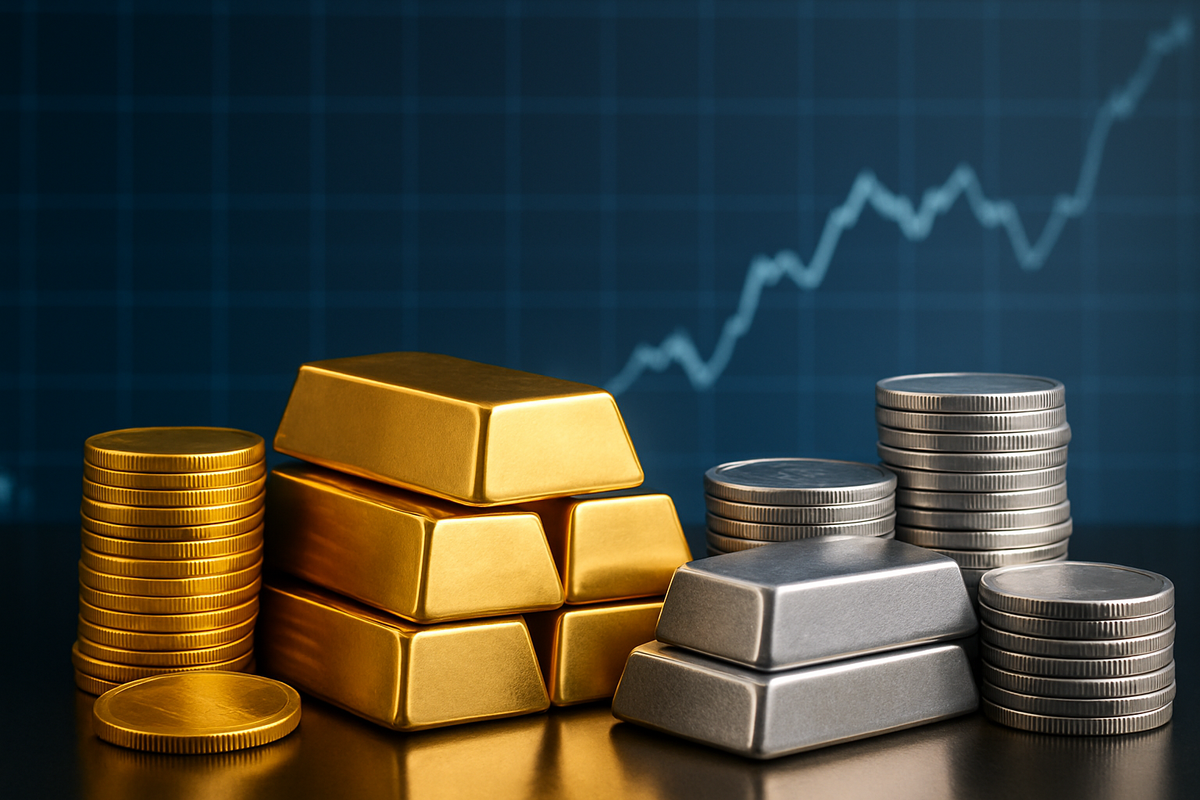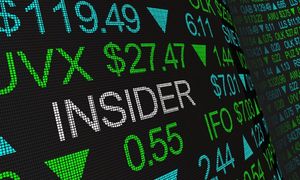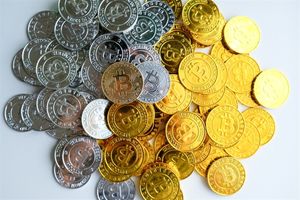
After a period of unprecedented gains, the roaring bull market for gold and silver appears to be taking a breath, entering what many financial experts are calling a "pausing" or "correction" phase as of October 2025. While recent profit-taking and short-term volatility have led to a pullback from record highs, a deeply entrenched bullish sentiment suggests that the long-term upward trajectory for precious metals remains firmly in place. Investors are currently navigating a complex landscape shaped by evolving monetary policies, persistent geopolitical tensions, and robust industrial demand, particularly for silver.
The immediate implications of this correction are a test of investor resolve and a potential opportunity for those looking to enter or increase their positions in precious metals. The market is currently consolidating, with gold hovering around $4,327 and silver near $51.64, after both reached new peaks earlier in the year. This period of adjustment is widely viewed as a healthy and expected development following an extraordinary rally, rather than an indication of the bull run's demise. The focus now shifts to whether this tactical retreat will provide a springboard for further gains or if more significant headwinds are on the horizon.
Navigating the Current Correction: Insights and Influences
The recent price declines in gold and silver, particularly in mid-October 2025, can be largely attributed to widespread profit-taking after both metals achieved all-time high valuations. This profit-taking, however, is occurring within a broader context of strong underlying demand and supportive macroeconomic factors. The market is currently pricing in at least two Federal Reserve rate cuts, reinforcing expectations for continued monetary easing. Lower interest rates typically diminish the appeal of yield-bearing assets, thereby increasing the attractiveness of non-yielding assets like gold and silver.
Geopolitical tensions continue to play a pivotal role in driving safe-haven demand. Fragile ceasefires in West Asia and the prolonged U.S. government shutdown, though intermittently easing, continue to inject uncertainty into global markets, bolstering the case for precious metals. Conversely, any signs of de-escalation, such as anticipated meetings between global leaders, have contributed to recent price pullbacks, highlighting the market's sensitivity to geopolitical shifts. Another significant tailwind for gold has been the weakening U.S. Dollar Index, which has fallen approximately 9% in 2025, making dollar-denominated gold more affordable for international buyers. Furthermore, central banks worldwide, especially in emerging economies, are consistently accumulating gold, providing a solid foundation of institutional demand.
Gautam Shah, the astute founder of Goldilocks Global Research, has been a notable voice in the precious metals space. As of June 2025, Shah held a distinctly bullish view on silver, predicting a substantial 25-30% surge in its prices by the end of the year. He observed silver outperforming gold and highlighted a significant breakout in the gold-to-silver ratio, signaling silver's burgeoning strength. At that time, Shah considered gold to have reached an "intermediate top" in the $3,400-$3,500 range, suggesting a period of consolidation before further upward movement. His analysis underscores the dual role of silver as both a monetary metal and a crucial industrial commodity, a factor increasingly driving its demand.
Corporate Fortunes: Winners and Losers in the Precious Metals Market
The current volatility and long-term bullish outlook for gold and silver will undoubtedly create both opportunities and challenges for public companies operating in the precious metals sector. Mining companies are particularly sensitive to price fluctuations, as higher metal prices directly translate to increased revenues and profitability.
Major gold miners like Barrick Gold (NYSE: GOLD) and Newmont (NYSE: NEM) stand to benefit significantly from a sustained bull run. While short-term corrections might impact their quarterly earnings due to lower realized prices or hedging strategies, the overall upward trend in gold prices provides a favorable environment for expanding margins and increasing exploration budgets. These companies, with their established operations and diversified portfolios, are often seen as relatively safer bets during precious metals rallies. Similarly, silver-focused producers such as Pan American Silver (NASDAQ: PAAS) and Wheaton Precious Metals (NYSE: WPM) are poised for substantial gains, especially given the strong industrial demand for silver. Their profitability will be directly boosted by silver's ascent, allowing for greater investment in new projects and potentially higher dividends for shareholders.
On the investment vehicle front, Exchange Traded Funds (ETFs) such as SPDR Gold Shares (NYSEARCA: GLD) and iShares Silver Trust (NYSEARCA: SLV) have seen robust inflows, particularly into gold ETFs, which have been a key driver of the rally. While silver ETF inflows have plateaued recently, signaling some investor fatigue, a renewed surge in prices could quickly reverse this trend. Companies providing ancillary services to the mining industry, from equipment manufacturers to geological consulting firms, could also see increased business activity as miners ramp up production and exploration efforts in response to higher metal prices. Conversely, companies heavily reliant on a stable or declining precious metals market, or those with significant short positions, could face considerable headwinds during a prolonged bull run. However, the prevailing sentiment is that the opportunities far outweigh the risks for most established players in this sector.
Broader Significance: A Return to Hard Assets
The current dynamics in the gold and silver markets are not isolated events but rather fit into broader industry trends emphasizing a return to hard assets and a search for inflation hedges. The expectation of continued monetary easing by central banks globally, coupled with persistent inflation concerns, makes precious metals an attractive store of value. This trend is further amplified by the ongoing geopolitical instability, which consistently drives demand for safe-haven assets.
Silver's unique position as both a precious metal and a critical industrial commodity lends it significant leverage in the current economic climate. Its increasing application in high-growth sectors such as solar energy, electric vehicles, artificial intelligence, and advanced electronics is creating a structural supply-demand imbalance. This burgeoning industrial demand, combined with its investment appeal, suggests that silver's bull run might have "just begun," as many experts argue it is poised to potentially outperform gold. Historically, during periods of high inflation and economic uncertainty, precious metals have served as reliable hedges, and the current environment strongly echoes these past precedents. Regulatory or policy implications, particularly concerning the Federal Reserve's interest rate trajectory, will continue to be a dominant factor, with further rate cuts likely to fuel the rally. The ripple effects extend beyond the metals sector, potentially drawing capital away from traditional financial assets and into commodities, influencing the broader investment landscape.
What Comes Next: Volatility and Opportunity
Looking ahead, the precious metals market is likely to experience continued volatility in the short term, but with a strong underlying bullish bias. Experts widely recommend a "buy on dips" strategy, advising investors to capitalize on price corrections rather than chasing the rally at its peaks. The immediate future will be shaped by upcoming U.S. economic data, including Consumer Price Index (CPI) and Purchasing Managers' Index (PMI) figures, which will provide further clues about the Federal Reserve's future rate decisions. Seasonal demand, particularly from India during its festival and wedding season (October to December), is also expected to provide additional support to prices.
In the long term, the outlook for both gold and silver remains overwhelmingly positive. Gold price projections are ambitious, with some forecasts suggesting a rise towards $4,400–$4,600 before a potential correction, and long-term targets ranging from $6,500 by 2027 to an astonishing $10,000 by 2030. Should inflation persist, interest rates continue to fall, and geopolitical stress intensify, gold could plausibly test $5,000 within the next 12 to 18 months. Silver's potential is even more striking, with expectations of it moving towards $60 before a pullback, and long-term targets reaching $200 or higher by 2030. Immediate targets for silver are $60–$65 within a year, with some anticipating $75–$100 in the next three to five years, largely driven by its robust industrial demand. The market opportunities lie in identifying and investing in companies and ETFs that are well-positioned to leverage these anticipated price increases, while challenges include managing short-term price swings and potential policy shifts.
A Resilient Bull: Positioning for the Future
In summary, while the gold and silver bull run has entered a necessary pausing or correction phase in October 2025, the overarching sentiment among financial experts points to a resilient and continuing long-term upward trend. Key takeaways include the significant role of profit-taking in recent declines, the persistent influence of monetary easing expectations, and the crucial impact of geopolitical tensions and robust industrial demand, especially for silver. Gautam Shah's bullish stance on silver, anticipating a substantial surge, further underscores the conviction in the sector.
Moving forward, the market is poised for continued dynamism. Investors should prepare for short-term volatility but remain focused on the strong fundamentals supporting precious metals. The ongoing weakening of the U.S. dollar, sustained central bank purchases, and silver's expanding industrial applications are powerful tailwinds. What investors should watch for in the coming months are the Federal Reserve's interest rate decisions, global inflation data, and any significant shifts in geopolitical stability. The current correction presents a strategic entry point for those believing in the enduring value and growth potential of gold and silver as essential components of a diversified portfolio in an uncertain world.
This content is intended for informational purposes only and is not financial advice






